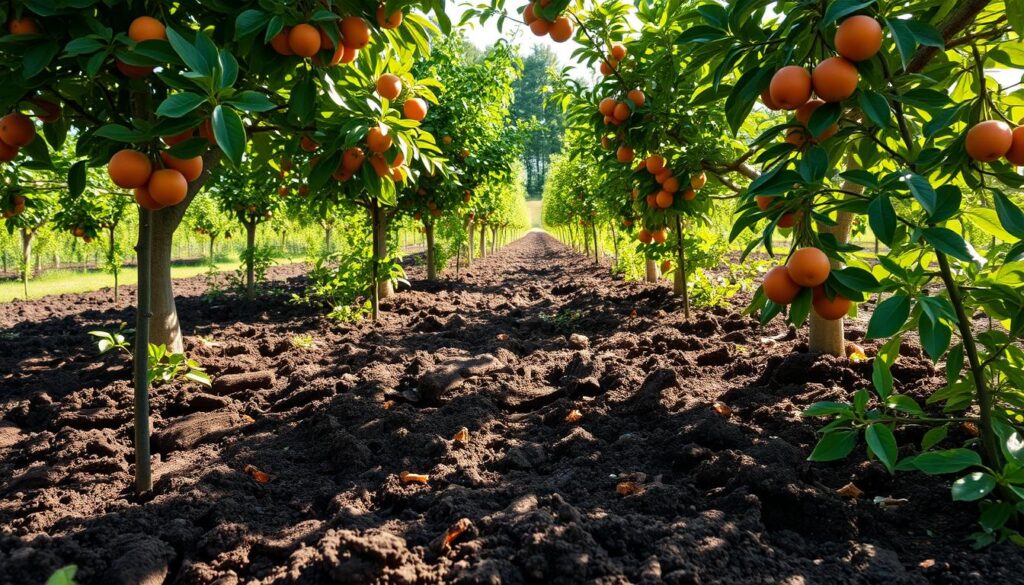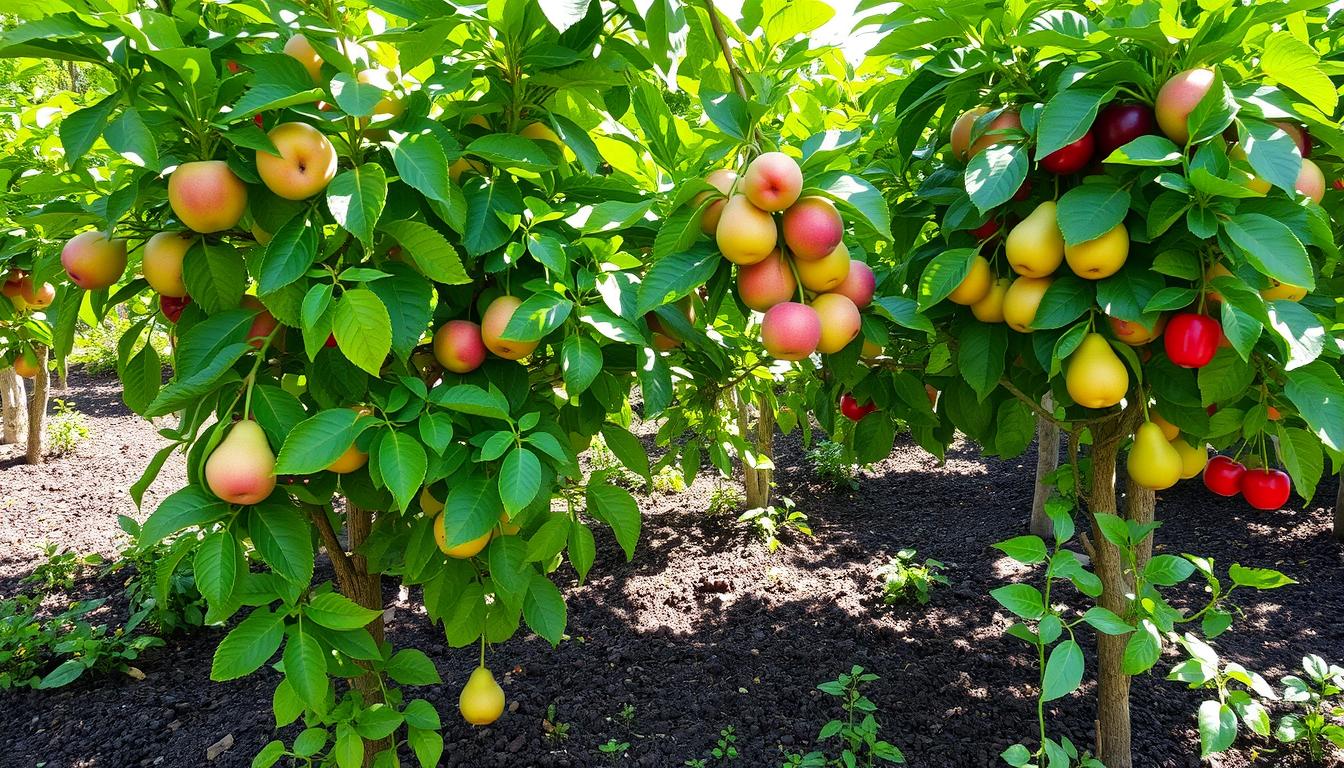Understanding the best soil for growing fruit trees at home is key. The right soil gives your trees the nutrients they need. It also helps them grow strong and produce lots of fruit. In this article, we’ll look at different soil types and how to make the best mix for your fruit trees.
We’ll use advice from experts and gardeners to help you. This way, even beginners can make great soil for their fruit trees.
If you want to learn more, check out Garden Beginner. It’s a site for new gardeners to learn and grow.
Key Takeaways
- Choosing the right soil is crucial for fruit tree health and production.
- Understanding soil characteristics, like drainage and fertility, aids in selecting the best mix.
- Different fruit trees have specific soil needs and spacing requirements.
- Organic soil options enhance biodiversity important for thriving fruit trees.
- Creating a custom soil mix can yield optimal results for home gardening.
Understanding Soil Types for Fruit Trees
The success of fruit trees in home gardening depends a lot on the fruit tree soil type. Certain soil types can greatly affect their growth and fruit yield. Loamy soil, with its mix of sand, silt, and clay, is often the top choice. It holds moisture well, drains water fast, and absorbs nutrients, perfect for many fruit trees.
While loamy soil is ideal, other soil types are also important. Sandy soil drains water too quickly, which is bad for young trees that need steady moisture. Clay soil holds too much water and is not good for fruit trees. But, with the right care, some trees can grow well in clay soil.
To improve fruit tree soil, adding organic matter like mulch is a good idea. It keeps moisture in and gives trees the nutrients they need. Young trees might need water every day, especially when they’re new. But, as they get older, they can handle less water and need it less often.
Knowing about these soil types is key for choosing the right home gardening soil. Always check your soil before planting trees. It affects how fast they grow and how well they produce fruit. For more gardening tips, look at books on pruning, disease control, and picking the right tree varieties. For more information, check this disclaimer link.
Importance of Soil Quality for Fruit Tree Growth
Soil quality is key for fruit trees to grow well. Good soil helps roots grow strong, keeping the tree healthy. It also lets the tree get the nutrients and water it needs.
Soil quality matters for many reasons. The pH level affects how nutrients are available. The right pH helps trees use soil minerals better. Also, organic matter in the soil improves its structure, helping with water and drainage.
Microbes in the soil are also crucial. They break down organic matter, making nutrients available to trees. Healthy soil is full of life, which fights pests and diseases, leading to better yields.
Improving soil quality is worth the effort for fruit trees. By adding compost, adjusting pH, and boosting microbes, you create a perfect environment for trees to thrive.
Best Soil for Growing Fruit Trees at Home
Choosing the right soil for fruit trees at home is key to their health and fruit production. Knowing what makes good soil helps me grow better fruit trees. With the right soil, my garden can be full of delicious fruits.
Key Characteristics of Optimal Soil Types
When picking soil for fruit trees, focus on a few important traits:
- Drainage: Good drainage stops root rot and diseases.
- Nutrient Density: Soil with lots of organic matter gives trees the nutrients they need.
- Aeration: Soil that lets in air helps roots grow well.
I’ve learned that the best mix for fruit trees includes compost, peat, and perlite. This mix is perfect for home fruit trees. It keeps moisture in and prevents soil from getting too hard.
Comparing Different Soil Compositions
To see how different soils affect my fruit trees, I compare them. Here’s a look at different mixes and their qualities:
| Soil Composition | Drainage | Nutrient Retention | Aeration |
|---|---|---|---|
| Standard Potting Mix | Good | Moderate | Excellent |
| Compost-Enriched Soil | Very Good | High | Good |
| Sandy Loam | Excellent | Low | Very Good |

Choosing the right soil mix is crucial for healthy fruit trees. Using a mix that suits my needs helps my trees grow well. For more on soil and privacy, see this privacy policy.
Benefits of Organic Soil for Fruit Trees
Choosing organic soil is crucial for growing healthy fruit trees. It’s more than just a place for roots to grow. Organic soil improves growth and is good for the environment. Adding compost, for example, makes the soil better, adds nutrients, and boosts microbes.
Enhancing Biodiversity with Organic Matter
Adding organic matter to the soil has many benefits. It helps create a home for beneficial microbes and earthworms. This ecosystem is key for nutrient cycling and air in the soil, which fruit trees need to thrive.
By using organic soil, I help my trees fight off diseases and pests. This lets them grow strong and healthy.
Long-term Soil Health and Productivity
Keeping soil healthy for the long term is important. Organic matter makes the soil better and helps it hold water. This means fruit trees can grow well for many seasons, giving consistent harvests.
If you want to improve your garden, learning about organic soil is a must. Check out this guide on soil preparation for more tips.
Choosing the Right Soil Amendments
Choosing the right soil amendments is key for fruit trees to thrive. The right mix improves soil structure and nutrient availability. This supports healthy tree growth. I’ll look at the importance of compost, mulch, and organic fertilizers.
Role of Compost in Soil Preparation
Compost is vital for soil preparation. It boosts soil’s organic matter, improving aeration and water absorption. This creates a home for beneficial microbes, helping plant health.
Compost also helps the soil hold nutrients better over time. This ensures fruit trees get the nutrients they need for growth.
Utilizing Mulch and Organic Fertilizers
Mulch offers many benefits, like keeping soil moist and stable. Organic mulches, like shredded leaves or wood chips, add nutrients as they break down. They also fight weeds, protecting fruit trees.
Organic fertilizers are crucial for nutrient availability. Using natural sources like fish emulsion or bone meal provides essential nutrients. This strengthens trees and helps them fight off environmental stress.
Topsoil vs. Potting Soil for Fruit Trees
It’s important to know the difference between topsoil and potting soil for fruit trees. Each type of soil has its own role in gardening. They meet different needs and conditions.
Defining Topsoil and Potting Soil
Topsoil is the top layer of soil, full of organic matter, minerals, and life. It’s not sterile and can have weeds, diseases, and fungi. It’s often heavy, holding water, which affects how well it drains.
Potting soil, on the other hand, is often soil-less. It might include peat moss or quick-draining materials. It’s light, drains well, and is great for growing plants in pots.
When to Use Each Type
For fruit trees planted in the ground, topsoil is usually the best choice. You can add organic matter to make it even better. It’s perfect for outdoor gardens or improving planting areas.
For fruit trees in pots, use a lighter mix like potting soil. A mix of sand, peat, and bark works well. It’s especially good for cherries, peaches, and figs.
Topsoil can be mixed with potting soil for raised beds. But, it might make containers drain poorly. Always check the soil’s pH level with a testing kit. Fertilizing regularly helps fruit trees grow and produce well.
Creating Your Own Fruit Tree Soil Mix
Making a fruit tree soil mix just for me is a big plus for growing healthy trees. I can mix the ingredients to fit the needs of each fruit tree type. The key parts are topsoil, compost, peat moss, and perlite, all helping the trees grow well.
Sphagnum peat moss is a mainstay in potting mixes because it holds water well and is light. Coir fiber is a green option. Perlite helps keep water in while keeping the mix airy, which is good for the roots. Each part is important for a balanced mix.
When I make my mix, I aim for the right mix to drain well and breathe. A common mix is:
| Ingredient | Recommended Ratio |
|---|---|
| Sphagnum Peat Moss | 50% |
| Perlite or Vermiculite | 25% |
| Coarse Sand | 15% |
| Compost | 10% |
Adding fertilizers keeps the soil rich in nutrients. I might add:
- Two teaspoons of potassium nitrate (15-0-15) for potassium.
- Two teaspoons of calcium nitrate (15.5-0-0) for calcium.
- Two level tablespoons of superphosphate (0-20-0) for phosphorus.
To get the mix just right, I sift it through hardware cloth. This makes it light and fluffy. I also make sure to pack the soil around the roots and add gravel at the bottom for good drainage. With these steps, my custom mix helps my fruit trees thrive, leading to great harvests.
Local Variations in Soil and Their Impact
Knowing about local soil conditions is key for growing healthy fruit trees. The soil’s makeup can change how fast trees grow, how good the fruit tastes, and how well they fight off pests and diseases. Soil texture, how well it drains, and what nutrients it has can differ a lot from place to place. By understanding these differences, I can pick the right soil for my fruit trees.
Understanding Your Regional Soil Composition
Every area has its own soil type, shaped by the earth’s history and the environment. I study the local landscape to learn about the soil. For example, clay soils hold water, which can be a problem for my trees. Sandy soils drain water fast, so I need to water and fertilize them more often.
Knowing these differences helps me choose the right soil for my trees. This way, I can make sure they get what they need to grow well.
Adapting Soil Choices According to Climate
The weather is also important for choosing the right soil for my fruit trees. In wet areas, I use raised beds to stop water from pooling and rotting the roots. In dry places, I pick trees that don’t need much water or add organic matter to keep the soil moist.
These changes in soil can really help my trees grow and produce fruit all season long. Taking care of graft unions is also something I keep in mind.
| Climate Type | Soil Adaptation | Recommended Fruit Trees |
|---|---|---|
| Wet | Raised beds for drainage | Apples, Pears |
| Dry | Organic matter for moisture retention | Peaches, Stone fruits |
| Mountainous | Terracing for soil stability | Cherries, Blueberries |
| Coastal | Salt-resistant soil mixes | Citrus, Figs |
Water Drainage and Retention in Fruit Tree Soil
Soil drainage is key for fruit tree health. Good drainage stops root rot and boosts growth. Finding the right water balance is vital for fruit tree success. This part talks about the need for well-drained soil and how to check it, keeping your trees hydrated.
Importance of Well-Drained Soil
Well-drained soil is crucial for fruit tree health. Sandy soils drain fast, needing more water. Clay soils hold water longer, needing less water. Knowing your soil type helps with drainage and watering.
How to Test Soil Drainage Capability
There are simple ways to test soil drainage. The percolation test is one. Dig a 12-inch hole, fill it with water, and wait for it to drain. Water should drain 6 to 12 inches in an hour. Slow drainage means you might need to add organic matter for better drainage and moisture.
| Soil Type | Drainage Rate | Water Retention Characteristics |
|---|---|---|
| Sandy Soil | Fast | Low water-holding capacity; requires frequent watering. |
| Clay Soil | Slow | High water retention; may cause root development issues. |
| Silty Soil | Moderate | Balances drainage and retention but may compact. |

Organic content is vital for fruit tree health. It helps with nutrient and moisture uptake. Knowing soil drainage needs helps create the right water balance for fruit trees, supporting their growth and productivity.
Adding Nutrients for Optimal Fruit Production
To get the most fruit from my trees, I need to know about soil nutrients. Nitrogen, phosphorus, and potassium are key for tree health. Magnesium and calcium help with fruit quality and tree strength.
Using organic fertilizers like compost and chicken manure boosts nutrient levels. It also makes the soil better for the roots, helping the tree grow strong.
Essential Nutrients for Fruit Trees
Fertilizing fruit trees right is all about timing and the right mix of nutrients. I fertilize in early spring to help them grow well. The amount of nitrogen needed depends on the tree’s age and growth rate.
For young trees, like peaches and nectarines, I look for 18″-24″ of growth. But for trees that bear fruit, they need less. This way, each tree gets what it needs to grow well.
Soil Testing for Customized Nutrient Management
Soil testing is key to tailoring nutrient care for my trees. It helps me see what’s missing and fix it. I mix slow-release and quick-release fertilizers for a boost now and later.
This approach helps my trees absorb nutrients better, over 80% from the soil. It keeps them healthy and fruitful for years.



Leave a Reply